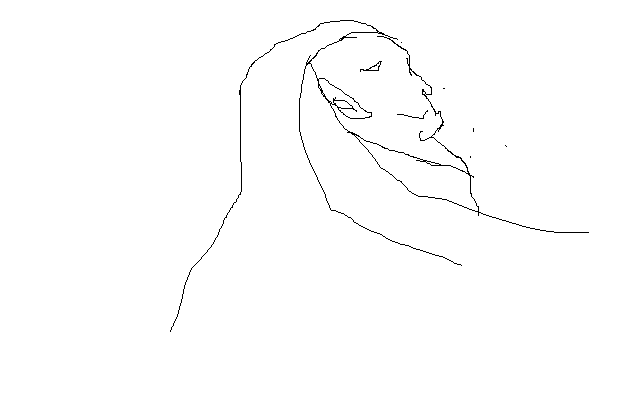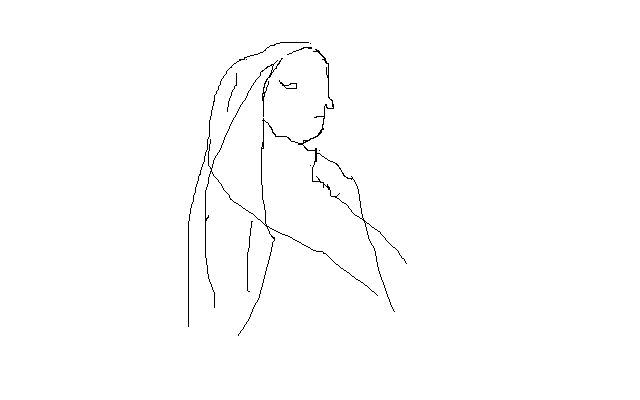Basic facts about the statues
“Colossal Head of a King. The sculpture was acquired by the museum in the 1920s. However, details in the carving have led the Egyptologists to re-asses the statue’s authenticity. In particular, the eyes and lips certainly do not reflect what is typical of late New Kingdom statuary.
Ancient Egyptians sometimes re-carved the statuary to reflect the features of a different owner. The large seated statue of Ramses II (E635) in this is an example; the statue was originally carved for a king of the middle kingdom.
Many hundred of years later, Ramses II had the head reworked to resemble himself. Its possible that this head originally belonged to a heavily eroded statue of ancient Egyptian king and was re-carved in modern times (in the 19 century) to make it more appealing. “
The next sketches represent the statue of the Egyptian King


“Limestone portrait of a roman matron. Babyke-Hierapolis (Membidijo), Syria 3rd century AD. This sculpture may be a portrait of Julia Maesa (d. AD 226), one of a group of prominent women in the severan dynasty who wielded considerable political and social power.
The austerity of the portrait is both symbolic of her strong character and representative of the unflattering and realistic way in, which 3rd century imperial women were portrayed.”
The next sketches are a representative of the aforementioned roman statue.


Comparison of the Roman and Egyptian sculptures
In the Roman and Egyptian culture, there was accentuation of the features, qualities and ideologies of a leader by using sculptures. Depending on the originality, each sculpture presented different characteristics. The sculptures of the limestone portrait of a Roman Matron and that of the colossal head of the Egyptian king have comparative features.
The artistic nature and the symbolic characteristics of each sculpture have a great difference. However, there are a few similarities, which are notable when comparing the sculptures. The next discussion compares the stylistic characteristics of the above sculptures.
The Egyptian sculpture is broad, wide and somehow assuming a triangle shape. The sculpture stands on a round base and only the facial features in addition to the neck are clear. In addition, there is the roman royal attire, which covers the head of the sculpture.
Thematically, this features shows that the sculpture belongs to one of the pharaoh. The large size of the portrait symbolically represents power and masculinity. The accentuation of the facial features like eyes, ears and nose adds reality to the sculpture.
Furthermore, the drawing of the head appears is on a flat surface that is, some of the characteristics of the head are absent. Authentically it is hard to give a full figure of a picture on a flat surface. Therefore, the profile presentation of the head is to ensure that only essential features like the complete face are visible.
There are vertical and horizontal lines and different shapes like triangles, oval and square, which add artistic features on the portrait. Therefore, the Egyptian sculpture enlightens the society on the heroic features of their leaders especially the pharaoh.
On the other hand, the second sculpture, which originates from the Roman’s society, presents different features. For instance, the sculpture is slender and longer with a around shape commonly referred to as stylistic cycle. This feature confirms that the sculpture is of a female leader.
This is because the sculpture emphasizes on the feminine characteristics like beauty especially through the face. The stylistic cycle is an artistic feature, which portrays reality. A closer look at the sculpture reveals looping folds, which adds reality to the portrait.
Although the portrait also has full-face features, it also encompasses the arms through halfway presentation. The high density of the drapery with folding fashion of the cloth covering the head and ornamented features on the forehead adds boldness and popularity to the portrait. This means the female leader presented similar features. They had both social and political power as their male counterparts.
The color of the sculpture is black but visually it is shinny and has a smooth surface. Normally, black color represents death, defeat or night. Thus, the portrait belongs to a deceased or fallen pharaoh. Curved from black granite stone the portrait is still in good condition and appears well reserved.
The Egyptian artists usually curved their sculptures from slabs of sandstone or limestone. Consequently, to preserve the originality and accentuate the reality of the sculpture, the carvings remained in their original color, as it is the case with the aforementioned sculpture. Critical analysis of the sculpture especially the head attire proves that it belongs to a king (pharaoh) and thus it is a portrait of a man.
Contrarily, the color of the Roman sculpture is a mixture of white and yellow. Critical observation shows that the portrait has rough finish. Normally, white color represents greatness, purity and power while the gold color represents imperishable. Thus, the portrait belongs to a female hero.
Due to the color, it proves that the curving of the portrait was from a white/yellow limestone. The color of the portrait also shows that the curving of the sculpture took place when the leader was alive.
Besides, purity white may also represent life. Finally, the carving of the sculptures occurred at different times. The curving of the roman sculpture occurred in the third century while that of the Egyptian curving was in the nineteenth century.
Nevertheless, the two sculptures also draw some similarities. For instance, both of the sculptures are symbolic and each of them represents eminent leaders. While the Roman sculpture represents a Roman matron, the Egyptian one represents a king (pharaoh).
Secondly, the artists used color to convey their message for example in the Roman statue white is a representation of purity while in the Egyptian sculpture black shows death. Each sculpture represents power and greatness.
Thirdly, the sculptures only accentuate the facial features meaning the artists used flat surface in drawing both of them. Finally, each sculpture has realistic features like color, clothing and presentation as shown in the images.
In brief, most ancient people used sculptures to promote their culture and leaders. Despite of origin, each sculpture had a symbolic message like power and equality. Intuitively, the aforementioned Roman sculpture gives emphasis on the political power of women.
On the other hand, the Egyptian sculpture adds value or honors the political leaders. Although the carving of the sculptures occurred at different times, they present similar stylistic features as discussed above.